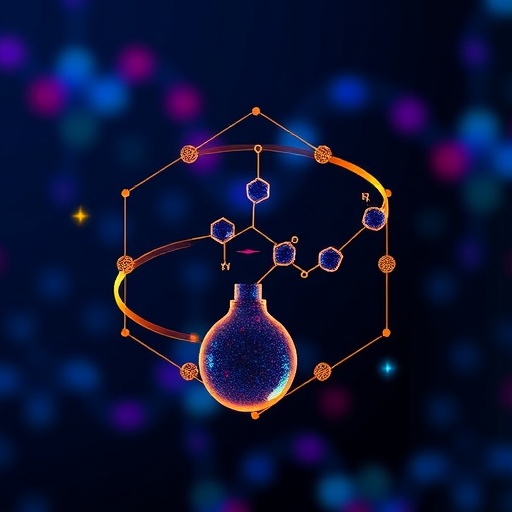In a groundbreaking advancement poised to revolutionize sustainable chemistry, researchers from the University of Michigan and Carnegie Mellon University have unveiled an innovative computational platform that dramatically enhances the accessibility of greener chemical synthesis. This novel tool, detailed in a pivotal study sponsored by the U.S. National Science Foundation and slated for publication in the esteemed journal Nature, addresses a critical challenge long hampering the widespread adoption of biocatalysis in synthetic chemistry.
Biocatalysts—or enzymes—are nature’s own molecular machines, proteins exquisitely evolved to facilitate complex chemical transformations with remarkable efficiency, typically under mild conditions such as aqueous environments at room temperature. These biological catalysts offer distinct advantages over conventional synthetic methods, eliminating the dependency on hazardous or costly chemical reagents. Nevertheless, their utility in the laboratory setting has been curtailed by their intrinsic selectivity: enzymes are highly specialized to catalyze reactions only with specific natural substrates they encounter in biological milieus. This specificity has historically limited chemists’ ability to harness their full synthetic potential across the immense diversity of molecules of interest outside natural contexts.
Recognizing this bottleneck, a collaborative effort led by Alison Narayan, a professor of chemistry at the University of Michigan and associate research professor at the Life Sciences Institute, embarked on bridging the longstanding disconnect between the vast chemical space explored by synthetic chemists and the protein sequence space characteristic of enzymes. Narayan emphasizes the transformative potential of this work: “Biocatalysis offers a more sustainable pathway to molecule construction, enabling access to structures unattainable through traditional techniques. Yet, the enzyme-substrate relationships chemists depend upon represent only a narrow sliver of nature’s molecular repertoire.”
The team’s strategy entailed comprehensively mapping enzyme-substrate compatibility within a specific family of enzymes, a process spearheaded by Alexandra Paton, then a postdoctoral researcher in Narayan’s group and current assistant professor at the University of Rochester. Paton engineered an advanced high-throughput reaction platform capable of systematically screening over 100 substrates against each enzyme variant across this family. This ambitious approach generated an unprecedented dataset revealing hundreds of previously unknown enzyme-substrate interactions, effectively delineating new regions of overlap between expansive chemical space and the enzyme universe.
Building upon this rich trove of empirical data, the collaboration further incorporated machine learning expertise from Gabe Gomes, assistant professor of chemical engineering and chemistry at Carnegie Mellon University, alongside graduate researcher Daniil Boiko. By training sophisticated predictive algorithms on these extensive mappings, the team created a dynamic model capable of predicting enzyme substrate specificity and catalytic potential with impressive accuracy. This machine learning-driven approach effectively translates complex molecular and protein sequences into actionable insights, enabling chemists to reverse-engineer enzymatic reactions tailored to their synthetic needs.
The culmination of this work is the publicly accessible CATNIP (Catalytic Nitrogen Incorporation Prediction) platform, an online tool that democratizes enzyme selection for green chemistry applications. Users input a target substrate or enzyme of interest and receive a ranked repertoire of candidate enzymes or substrates, respectively, prioritized by their predicted likelihood to catalyze the desired chemical transformation. Conceptually analogous to sophisticated web search engines, CATNIP leverages machine learning to sift through massive biological and chemical databases, accelerating enzyme discovery and rational synthetic design.
This platform marks a milestone in synthetic biocatalysis, shifting it from serendipitous discovery towards rational, data-driven design. Paton notes, “CATNIP offers an invaluable starting point to streamline synthetic campaigns employing biocatalysis. The integration of empirical data with computational prediction paves the way to expanding beyond known enzyme families, thereby vastly enlarging the toolkit available to chemists worldwide.”
The research is a testament to interdisciplinary collaboration, united by a shared commitment to sustainability and innovation. Alongside Narayan, Paton, Gomes, and Boiko, contributing authors include Jonathan Perkins and Nicholas Cemalovic from the University of Michigan, and Thiago Reschützegger from Brazil’s Federal University of Santa Maria. Their collective efforts underscore the synergy between experimental chemistry, protein engineering, and artificial intelligence in propelling modern science forward.
Through this breakthrough, the chemical synthesis community gains a powerful framework to overcome the traditional hurdles of enzyme selectivity, enabling the eco-friendly manufacture of pharmaceuticals, materials, and fine chemicals. The CATNIP platform’s open-access model ensures that researchers globally can tap into this resource, fostering a new era where the promise of biocatalysis can be fully realized.
As the team continues refining and expanding the platform, the prospect of integrating other enzyme families looms on the horizon, broadening the scope of accessible biocatalytic reactions. This accelerating trend aligns with the broader environmental imperative to transition chemical manufacturing towards greener, safer methodologies, reaffirming the vital role of innovation at the intersection of life sciences and engineering.
The published study, titled “Generation of connections between protein sequence space and chemical space to enable a predictive model for biocatalysis,” provides a comprehensive description of the platform’s development, validation, and potential applications. As the embargo lifts, the scientific community anticipates extensive engagement with this resource, heralding a future where enzymatic catalysis is seamlessly integrated into mainstream synthetic chemistry workflows.
This pioneering effort not only enhances our molecular toolkit but also exemplifies how data-driven solutions can redefine foundational practices in science. By unlocking the latent reactivity within enzymes beyond their natural substrates, these researchers have charted a path toward more sustainable, efficient, and innovative chemical synthesis paradigms.
Subject of Research:
Article Title:
News Publication Date:
Web References: https://catnip.cheme.cmu.edu/
References: DOI: 10.1038/s41586-025-09519-5
Image Credits:
Keywords
Physical sciences, Chemistry




